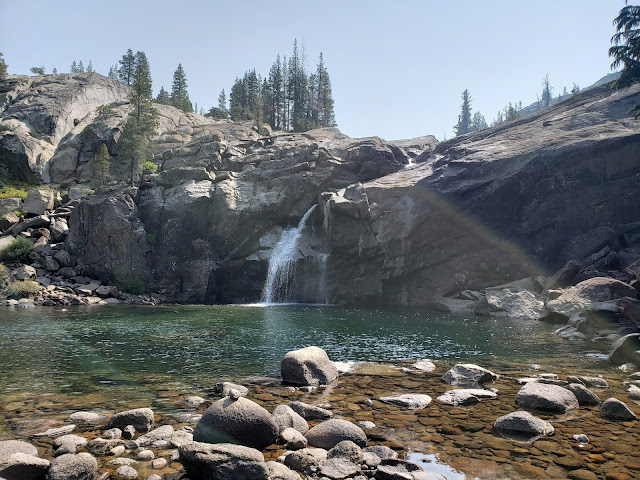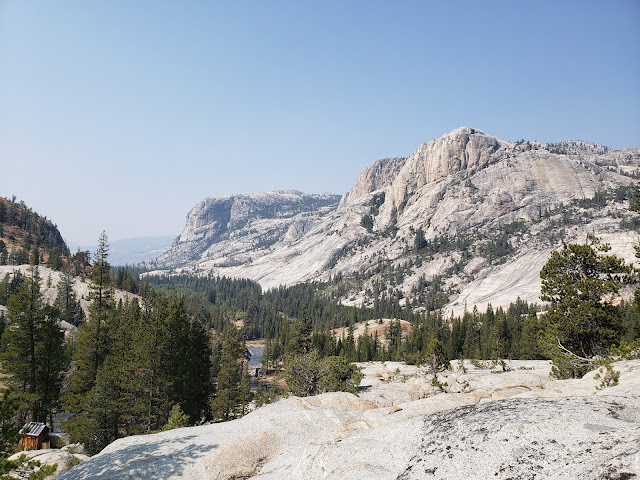Lighten up while you still can
Don't even try to understand
Just find a place to make your stand
And take it easy.
~Take it Easy (Eagles)
The Dude abides.
I don't know about you, but I take comfort in that,
knowin' he's out there. The Dude.
Takin' 'er easy for all us sinners.
~The Stranger (The Big Lebowski)
Foiled by Fire - Tahoe Rim and Jennie Lakes
Several months back, when the hills were still rich with vegetation and the reverberating echoes of Spring deceived me into believing that fire season in California wasn't really a thing, I dreamed of taking a late-season, multi-day backpacking trip with my kids and some old friends. California's backcountry is immense, so the possibilities then seemed limitless. Thus, along with my backpacking co-conspirators, we began pouring over topographic maps, researching trail descriptions, and plotting potential routes through the forests and ranges that comprise the vast Sierra Nevada. Ultimately, we settled on a section of the Tahoe Rim Trail, a 165 mile path that circumnavigates the famous sapphire pool that straddles the California-Nevada border. That selection seemed to have everything that an outdoor enthusiast could possibly desire: scenery, easy access, scenery, adequate water, and scenery. Plus, it was proximate to post-adventure beer and tacos. That was the real clincher.
And then in mid-August, as the date for our departure began to creep over the horizon, the Caldor Fire ignited and the El Dorado Forest near Lake Tahoe began to burn. As the conflagration raged out of control and evacuation orders forced locals to flee to wetter ground, smoke darkened the skies and ash rained down over the Tahoe Basin. The best laid plans...
So we scouted alternatives and settled on the Jennie Lakes Wilderness near Sequoia-Kings Canyon ("SEKI"). It hit all the same marks as the Tahoe Rim Trail save nearby tacos and beer. We decided we could adjust to that minor imperfection and major inconvenience.
And then it happened again. The KNP Complex fire ignited and suddenly SEKI was ablaze too. The fire began in the south, but steadily marched northward threatening the world's largest tree by volume and closing the park. Foiled yet again, we scrambled for a back-up to our back-up and miraculously found enough available permits for the Murphy Creek Trail in Yosemite. If the Tuolumne Basin started to burn, we were done. We'd just stay home and pout.
But Yosemite didn't burn. So on a Thursday afternoon, we all converged on the trailhead along Tioga Pass Road, strapped on our packs that were heavy with whiskey and other goodies that would make the ultra-light set squeamish, and headed into the wilderness.
Murphy Creek Trail to Polly Dome Lake
The Murphy Creek Trail is a short, flat, and pleasant walk through a lush coniferous forest that is occasionally interrupted by brilliant granite slabs that have polished smooth by the ancient glaciers that created this place. Classic Yosemite. About 2 miles in, a use trail branches to the right that takes you to the western edge of pretty Polly Dome Lake.
The original plan, conceived when we were feeling ambitious about our adventure, was to hike to Polly Dome Lake for the first night, down to Glen Aulin along the Tuolumne River the second night, back to May Lake the third night, then out the morning of the fourth day. But after we arrived at Polly Dome Lake and set up camp, we decided to embrace our inner Dude and just take 'er easy. We'd use Polly Dome as our base the whole time and just day-hike to our planned destinations. That way, we could avoid the unnecessary hassle of repeatedly putting up and tearing down camp.
Day Hike to the High Sierra Camp at Glen Aulin
The following morning we brewed coffee in the cool mountain air. Inexplicably, the exact same coffee that you drink at home every single day suddenly becomes a gourmet experience when consumed from a titanium mug under a canopy of regal evergreens. If only I could say the same thing about food (Top Ramen excepted) which I find to be largely unappetizing at elevation.
Anyway, sufficiently juiced up on caffeine, we then headed to Glen Aulin for the day which was a little less than 5 miles to our northeast. It was a slow descent on a beautiful, well maintained trail that permitted occasional looks at various peaks that stud the Tioga Pass area. At McGee Lake, a finger-like lake along the trail, we stopped for a brief spell to try our hands at swimming and fishing. Neither endeavor was particularly successful. We then made the final drop to Glen Aulin where the Tuolumne River comes spilling of the cliffside into a large, emerald pool. There's a High Sierra camp at Glen Aulin with bathrooms, water, and bear boxes, but all of it was locked tight and the camp was empty of campers.
Ultimately, the nearby water proved too enticing, so we all gleefully stripped off our clothes and jumped into the waiting pool. A day-hiker nearby watched in bemusement. Almost immediately, we regretted our impulsiveness as the water was surprisingly frigid and major shrinkage ensued for all those with appendages that could shrink. We then sat like lizards in the sun, warming our now cold blood.
On the way back to camp later that afternoon as my mind had wandered off as I wandered along, my friend suddenly exclaimed "bear!" I immediately snapped to attention, and sure enough, about 30 yards up-trail blocking our way was a very large black bear. When we checked in to obtain our permits, the ranger told us that bears were very active in the park and to expect a visit to camp every night, but that never happened. This was the only bruin we would see. As the bear ambled down trail toward us, we all started yelling and clapping our hands like fools to no avail. The bear was completely unfazed by our antics and continued slowly toward us. As we started to search the ground for projectiles, the bear moved off trail and we slid by without incident making it back to camp with a tale to tell.
May Lake, the Geographic Center of Yosemite
The following day, we made the 4-mile trek to May Lake, the "geographic center" of the park. May Lake is a gorgeous high-country lake that sits in a basin beneath stark and towering Mt. Hoffmann. We briefly contemplated making an attempt at Hoffmann's summit, but consistent with our adopted Dude-aesthetic, we decided to simply sit shoreside and admire it from afar.
There's also a High Sierra camp at May Lake replete with bathrooms, water, and bear boxes. Like Glen Aulin, the bathrooms and water here were non-functional. Unlike Glen Aulin, the bear boxes here were unlocked and stuffed to the gills. Loafs of bread, bottles of ketchup and mustard, and edibles of all types were crowded in, on, and under every box. And the camping area was congested with campers. It was a bit of a shit show even though it was late season. I suppose that is understandable given that May Lake is easily accessible from Tioga Pass Road via a mile and one-half trail. But as scenic and worthwhile as it was to visit for the day, we were quite happy to return to lonely Polly Dome for the night.
Leaving Yosemite - the Last Day
On the final morning, we walked out, retracing our steps from day one. As always seems the case when you've been out a few days, we were both ready and reluctant to go. So we got moving early, but moved slowly, savoring the last moments of high-country bliss. Back at the trailhead, we unloaded our packs and retrieved the cans of malt and grain beverages that were stowed in the nearby bear boxes. We were going to just leave those in the trunk, but the ranger told us that bears can smell sealed beer through an aluminum can. Although we skeptically viewed that tidbit of information as nothing more than ranger scare-mongering, and despite the threat of theft by fellow hikers and hooligans, we ultimately were obedient little soldiers and stashed our stash in the bear boxes. And the beer survived the ordeal.
On the way down 395, we were hankering for some real food. After a couple of days of trial mix and tuna pouches and trail mix, we could think of nothing but burgers and fries and burgers, so stopped in Mammoth Lakes at the brewery to quell our hunger pangs and slake our thirst with a frosty mug. It was all very Dude and the perfect compliment to a good couple of days in the mountains.
























































